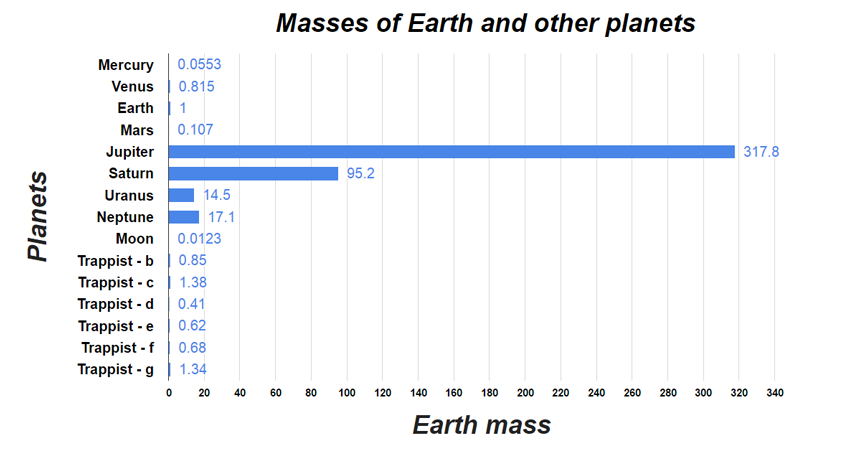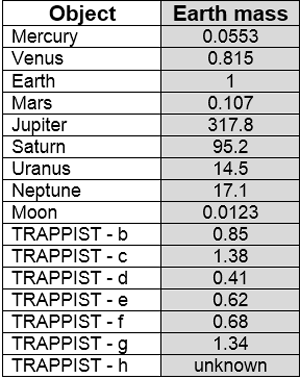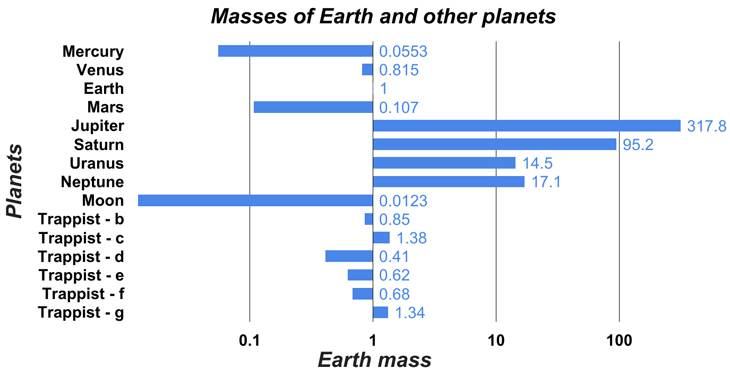Analyze This: The masses of planets
Many of the newly discovered planets in the TRAPPIST system have masses similar to Earth

This graph compares the mass of the planets in our solar system to that of planets in the newly discovered TRAPPIST-1 solar system. Some of the planets are smaller than Earth, and some are much larger.
L. Steenblik Hwang
Recently, scientists announced the discovery of a nearby solar system with seven planets similar in size and mass to Earth. The system is named TRAPPIST-1, after its central star. And three of its planets might sit in the star’s Goldilocks zone. That means those planets might be in a good place to harbor life.
But how do scientists know the sizes of these planets? How do they even know how big Earth is?
Story continues below video
The first thing to understand is that the mass of the Earth is not the same as its weight, even though both are measured in kilograms. Mass is how much stuff is in something. Weight is how much that mass is impacted by gravity.
Your weight on Earth is how much Earth’s gravity is attracting you to the surface of the planet. That weight can change depending on what planet or moon you’re on. For example, if you weigh 45 kilograms (100 pounds) on Earth, on the moon you would weigh 7.5 kilograms (16.6 pounds) and in space you’d weigh nothing at all. But in each of these places your mass is 45 kilograms and wouldn’t change. You’d always have a mass of 45 kilograms.
To have weight, you have to have something exerting gravity on you (or whatever you are trying to weigh). Earth has objects like the moon and sun exerting their gravity on it, but those pulls are negligible in terms of weight. This is why we are more concerned with mass than weight for planets, moons and suns.
The masses of these objects are really big. So the standard measurement for them is in terms of the mass of Earth. One Earth mass is equal to 5.9722×1024 kilograms. (1024 is shorthand for 1 with 24 zeroes written after it.) Scientists have figured out Earth’s mass using the planet’s gravitational pull and math.

To determine the mass of planets other than Earth, scientists need to study the tug of gravity between the planet and another object, such as a moon or star. Researchers can observe how something orbits another planet, or how that planet orbits a star, and use that information to estimate the mass of a planet.
Scientists also can observe how much light was blocked by each planet during transit (when the planet passes between its star and the Earth) and use that information to estimate planetary mass.
Let’s look at the mass of some planets in our solar system compared to the mass of TRAPPIST planets. The data in this table (except for Trappist – h, of course) was used to create the graph at the top of the page. But there are other ways to graph those data. Here’s another example:

Data dive:
None of the TRAPPIST planets are exactly the size of Earth. In your view, are they close enough to be called Earth-sized?
Are there any other planets in Earth’s solar system that might be a better comparison to the TRAPPIST planets?
Did you find the first graph easy to understand? Why or why not? What about the second graph on this page?
How else might you graph these data?
Analyze This! explores science through data, graphs, visualizations and more. Have a comment or a suggestion for a future post? Send an email to sns@sciencenews.org.







